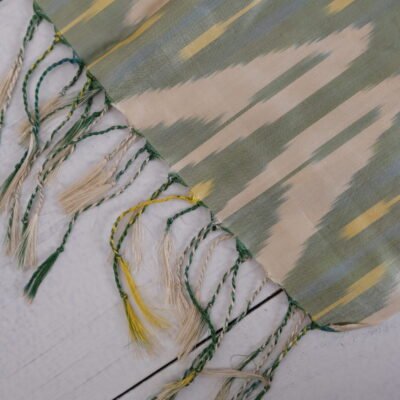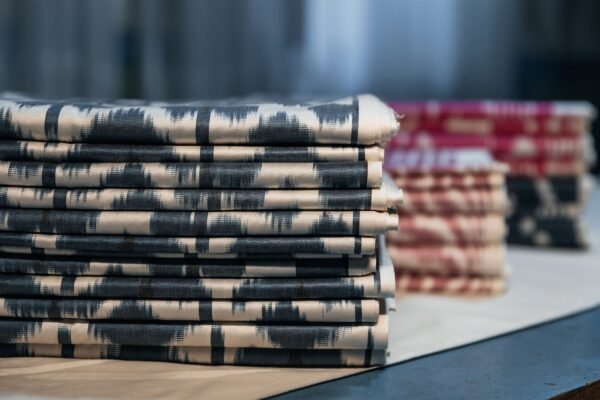The Rich History of Silk Ikat Scarves
The journey of Silk Ikat scarves begins with a tale woven through time. Originating from the term "mengikat" in Indonesian, which means "to tie," the Ikat technique involves a resist dyeing process where threads are dyed before they are woven to create intricate patterns. This method has been perfected over centuries, with evidence of Ikat textiles being produced in civilizations as diverse as pre-Columbian South America and ancient India.
Silk, the material of choice for these scarves, has a history equally as illustrious. Revered for its luster and luxurious feel, silk has been cultivated for over 5,000 years, predominantly in China. The convergence of silk with the Ikat technique resulted in a product that was highly sought after, not only for its aesthetic appeal but also for its demonstration of a weaver's skill.
The spread of the Silk Ikat scarf can be traced along the historic Silk Road, a network of trade routes that connected the East and West. As these scarves traveled, they carried with them the stories of their origin, becoming a symbol of cultural exchange and influence. The Silk Ikat became not just a commodity but a canvas that reflected the values, myths, and artistic expression of the people who crafted them.
The Silken Touch: Exploring the Health Benefits of Silk Ikat Scarves
Beyond their historical significance, Silk Ikat scarves also provide a range of health benefits. Silk, as a natural protein fiber, contains a number of amino acids that are beneficial to the skin. It is hypoallergenic, making it suitable for those with sensitive skin, and its smooth surface can help reduce irritation and prevent damage to hair when used as a headscarf.
The breathable nature of silk ensures that it remains cool in summer and warm in winter, adapting to the body's temperature. This temperature regulation property makes Silk Ikat scarves a comfortable accessory regardless of the season. Moreover, silk's moisture-wicking capabilities mean that it can absorb perspiration while allowing the skin to breathe, maintaining a sense of freshness throughout the day.
Silk's natural properties also include resistance to dust mites, mold, and other allergens. For those who prioritize cleanliness and health, a Silk Ikat scarf serves as a chic protective layer. Whether draped around the neck or covering the hair, it offers a barrier against environmental irritants while promoting skin and hair health.
Silk Ikat Scarf: The Craftsmen Behind the Looms
Behind every Silk Ikat scarf is a story of dedication and artistry. The craftsmen who produce these exquisite pieces are often part of a lineage of weavers, with the knowledge of the Ikat technique passed down from generation to generation. The creation of a Silk Ikat scarf is a labor-intensive process that begins with the careful selection of silk threads.
The chosen threads are then bound in a pattern and resist-dyed, a meticulous process that can be repeated multiple times to achieve the desired colored patterns. After the dyeing is complete, the threads are lined up on the loom with great precision to ensure that the pattern comes out perfectly as the weaving progresses.
The weavers' skill lies not only in their ability to envision and dye complex patterns but also in their dexterity to weave the threads into a cohesive fabric. This process can take days or even weeks, depending on the complexity of the design. The result is a one-of-a-kind Silk Ikat scarf, imbued with the individual touch of the artisan who created it.
Silk Ikat Scarves in Fashion Today
In contemporary fashion, Silk Ikat scarves have found a place as a statement accessory that transcends seasonal trends. Designers and fashion enthusiasts alike are drawn to these scarves for their bold patterns, rich colors, and the sense of exclusivity that comes with wearing a handcrafted piece.
On the runways, Silk Ikat scarves have been incorporated into collections as diverse as haute couture and ready-to-wear, showcasing their versatility. They serve as a nod to traditional craftsmanship within the modern wardrobe, often acting as a counterpoint to minimalist or monochromatic outfits by adding a splash of color and texture.
Furthermore, the growing emphasis on sustainability in the fashion industry has brought Silk Ikat scarves into the spotlight. As consumers become more conscientious about the origins of their clothing, the appeal of ethically made, artisanal items has increased. Silk Ikat scarves, with their artisanal background and sustainable production methods, align perfectly with this shift towards mindful consumption.
Unique Designs and Patterns in Silk Ikat Scarves
The allure of Silk Ikat scarves lies in their distinct designs and patterns, each telling a different story. The motifs found in Ikat patterns range from geometric shapes to symbolic imagery, often inspired by the natural world, religious iconography, or cultural narratives. These designs are not merely decorative; they are a language in their own right, communicating messages of status, identity, and community.
Ikat patterns are also region-specific, with different areas developing their unique styles and color palettes. For example, the Silk Ikat scarves from Central Asia are renowned for their vibrant hues and bold motifs, while those from Japan, known as "kasuri," typically feature more subtle colors and delicate patterns.
The uniqueness of each Silk Ikat scarf is further accentuated by the variations that occur during the hand-dyeing process. No two scarves are exactly alike, giving each piece its individual character—a testament to the human touch involved in its creation.
Styling Tips for Silk Ikat Scarves
To integrate a Silk Ikat scarf into one's wardrobe is to invite a touch of artisanal sophistication. These scarves can be styled in numerous ways to suit various occasions and personal tastes. For an effortless chic look, one might simply drape the scarf over the shoulders or tie it loosely around the neck, allowing the pattern to be the focal point.
For a more structured appearance, a Silk Ikat scarf can be folded into a triangle and wrapped around the neck, with the ends tied at the front. This method accentuates the neckline and can add a polished finish to a business or casual ensemble.
When it comes to incorporating Silk Ikat scarves into formal wear, they can be used as a shawl or evening wrap, providing warmth and elegance. The intricate patterns of the scarf can complement a simple gown, adding a layer of visual interest and cultural depth to an outfit.
From Casual to Formal: Versatile Ways to Wear Ikat
The versatility of Silk Ikat scarves extends far beyond traditional styling methods. These accessories can transition seamlessly from casual daytime wear to formal evening attire. For a casual look, a Silk Ikat scarf can be tied around the waist as a belt or wrapped around the head as a bohemian headband.
In the workplace, a Silk Ikat scarf can serve as a sophisticated necktie alternative or be looped around the handle of a briefcase for an unexpected pop of pattern. For formal occasions, a Silk Ikat scarf can be draped over the arms as an elegant stole or used to accessorize a clutch bag.
The transformative nature of the Silk Ikat scarf makes it an indispensable item in a well-curated wardrobe, adaptable to any style and occasion while always maintaining an air of refined artistry.
Caring for Your Silk Ikat Scarf
To preserve the beauty and longevity of a Silk Ikat scarf, proper care is essential. Silk is a delicate fiber that requires gentle handling to maintain its texture and color vibrancy. It is recommended to hand wash Silk Ikat scarves in cool water with a mild detergent, avoiding harsh chemicals that could damage the fabric.
After washing, the scarf should be laid flat or hung to dry away from direct sunlight, which can fade the colors. Ironing should be done on a low heat setting, and it is advisable to place a cloth between the iron and the scarf to protect the silk's delicate surface.
Storing Silk Ikat scarves is also an important consideration. They should be kept in a cool, dry place, ideally wrapped in breathable fabric or stored in a box to prevent dust accumulation and to maintain their shape.
The Ethical Choice: Supporting Sustainable and Traditional Crafts
Choosing a Silk Ikat scarf is not only a style statement but also an ethical decision. By purchasing these handcrafted textiles, one supports the livelihoods of artisans and helps preserve a traditional craft that might otherwise fade into obscurity.
The production of Silk Ikat scarves is often sustainable, with a low environmental impact compared to mass-produced textiles. The dyes used are frequently derived from natural sources, and the small-scale production ensures that each scarf is made with attention to detail and quality.
In a world where fast fashion dominates, opting for a Silk Ikat scarf is a step towards a more conscious and responsible approach to fashion. It is an investment in a piece that is not only aesthetically pleasing but also holds cultural significance and promotes ethical practices.
Conclusion: The Enduring Beauty of Silk Ikat Scarves
Silk Ikat scarves are more than just a luxurious accessory; they are a celebration of history, craftsmanship, and sustainable fashion. With their rich heritage, health benefits, and versatility in styling, these scarves have stood the test of time and continue to captivate those who appreciate their artisanal elegance.
The beauty of Silk Ikat scarves endures not just in their visual appeal but in the stories they carry and the traditions they uphold. In choosing a Silk Ikat scarf, one embraces a piece of cultural heritage, contributes to the sustainability of the craft, and enjoys the timeless sophistication it brings to any wardrobe.
As we continue to explore the intersection of fashion and tradition, the Silk Ikat scarf remains a shining example of how the two can coexist harmoniously, bringing the past into the present with grace and style.



